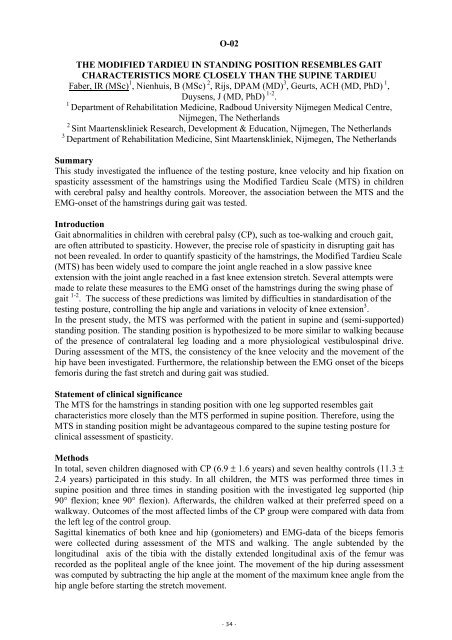1st Joint ESMAC-GCMAS Meeting - Análise de Marcha
1st Joint ESMAC-GCMAS Meeting - Análise de Marcha
1st Joint ESMAC-GCMAS Meeting - Análise de Marcha
Create successful ePaper yourself
Turn your PDF publications into a flip-book with our unique Google optimized e-Paper software.
O-02<br />
THE MODIFIED TARDIEU IN STANDING POSITION RESEMBLES GAIT<br />
CHARACTERISTICS MORE CLOSELY THAN THE SUPINE TARDIEU<br />
Faber, IR (MSc) 1 , Nienhuis, B (MSc) 2 , Rijs, DPAM (MD) 3 , Geurts, ACH (MD, PhD) 1 ,<br />
Duysens, J (MD, PhD) 1-2 .<br />
1 Department of Rehabilitation Medicine, Radboud University Nijmegen Medical Centre,<br />
Nijmegen, The Netherlands<br />
2 Sint Maartenskliniek Research, Development & Education, Nijmegen, The Netherlands<br />
3 Department of Rehabilitation Medicine, Sint Maartenskliniek, Nijmegen, The Netherlands<br />
Summary<br />
This study investigated the influence of the testing posture, knee velocity and hip fixation on<br />
spasticity assessment of the hamstrings using the Modified Tardieu Scale (MTS) in children<br />
with cerebral palsy and healthy controls. Moreover, the association between the MTS and the<br />
EMG-onset of the hamstrings during gait was tested.<br />
Introduction<br />
Gait abnormalities in children with cerebral palsy (CP), such as toe-walking and crouch gait,<br />
are often attributed to spasticity. However, the precise role of spasticity in disrupting gait has<br />
not been revealed. In or<strong>de</strong>r to quantify spasticity of the hamstrings, the Modified Tardieu Scale<br />
(MTS) has been wi<strong>de</strong>ly used to compare the joint angle reached in a slow passive knee<br />
extension with the joint angle reached in a fast knee extension stretch. Several attempts were<br />
ma<strong>de</strong> to relate these measures to the EMG onset of the hamstrings during the swing phase of<br />
gait 1-2 . The success of these predictions was limited by difficulties in standardisation of the<br />
testing posture, controlling the hip angle and variations in velocity of knee extension 3 .<br />
In the present study, the MTS was performed with the patient in supine and (semi-supported)<br />
standing position. The standing position is hypothesized to be more similar to walking because<br />
of the presence of contralateral leg loading and a more physiological vestibulospinal drive.<br />
During assessment of the MTS, the consistency of the knee velocity and the movement of the<br />
hip have been investigated. Furthermore, the relationship between the EMG onset of the biceps<br />
femoris during the fast stretch and during gait was studied.<br />
Statement of clinical significance<br />
The MTS for the hamstrings in standing position with one leg supported resembles gait<br />
characteristics more closely than the MTS performed in supine position. Therefore, using the<br />
MTS in standing position might be advantageous compared to the supine testing posture for<br />
clinical assessment of spasticity.<br />
Methods<br />
In total, seven children diagnosed with CP (6.9 ± 1.6 years) and seven healthy controls (11.3 ±<br />
2.4 years) participated in this study. In all children, the MTS was performed three times in<br />
supine position and three times in standing position with the investigated leg supported (hip<br />
90° flexion; knee 90° flexion). Afterwards, the children walked at their preferred speed on a<br />
walkway. Outcomes of the most affected limbs of the CP group were compared with data from<br />
the left leg of the control group.<br />
Sagittal kinematics of both knee and hip (goniometers) and EMG-data of the biceps femoris<br />
were collected during assessment of the MTS and walking. The angle subten<strong>de</strong>d by the<br />
longitudinal axis of the tibia with the distally exten<strong>de</strong>d longitudinal axis of the femur was<br />
recor<strong>de</strong>d as the popliteal angle of the knee joint. The movement of the hip during assessment<br />
was computed by subtracting the hip angle at the moment of the maximum knee angle from the<br />
hip angle before starting the stretch movement.<br />
- 34 -
















